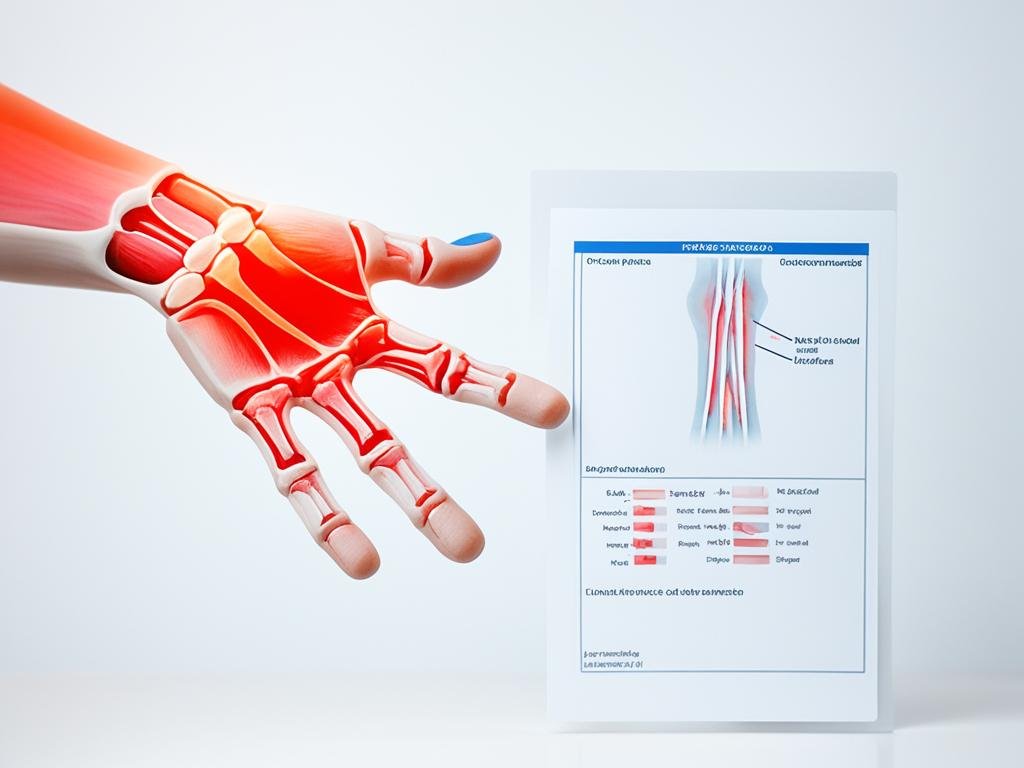Imagine feeling painful stiffness in your joints. This could be a sign of rheumatoid arthritis. It affects millions worldwide and goes beyond achy joints. It’s a serious illness that can harm more than joints.1 Rheumatoid arthritis makes your immune system attack your joints. This leads to swelling, pain, and even lasting damage.2
This guide will explore rheumatoid arthritis deeply. We’ll look at its symptoms, causes, and the newest treatments. This knowledge will help you manage the condition better and improve your life.
Key Takeaways
- Rheumatoid arthritis is an autoimmune disorder that causes joint inflammation and pain.
- The condition is characterized by painful, swollen, and stiff joints, often affecting the same joints on both sides of the body.
- Rheumatoid arthritis can lead to joint damage, limited mobility, and other health complications if left untreated.
- Early, aggressive treatment is crucial to reduce or stop inflammation and prevent permanent damage.
- Lifestyle modifications, such as a balanced diet and heat treatments, can also help manage symptoms.
What is Rheumatoid Arthritis?
Rheumatoid arthritis is an autoimmune disorder where the immune system attacks the tissue around joints.1 This attack causes inflammation, swelling, and pain in the joints.1 It often affects the hands, knees, and ankles. These symptoms usually appear on both sides of the body.1
An Autoimmune Disorder
In rheumatoid arthritis, the immune system doesn’t work right. It attacks healthy joint tissues, leading to inflammation and damage. This damaging response is a big part of the condition.
Joint Inflammation and Pain
The body’s defense system attacks joint tissues in this condition. This causes inflammation, which leads to swelling, stiffness, and joint pain. Daily movements and activities can become hard and painful for those with this condition.
Symptoms of Rheumatoid Arthritis
Feeling pain or tenderness in small joints may be an early sign of rheumatoid arthritis (RA). This includes fingers, toes, as well as large joints like knees or shoulders.1 The swelling that comes with RA can make you stiff, especially in the morning. And moving may be more difficult.1 Also, RA can cause fatigue and sometimes a mild fever.1 These issues might happen off and on, with better and worse times.2
Joint Pain and Swelling
Rheumatoid arthritis often shows up as joint pain, tenderness, and swelling. It usually hits the same joints on both sides of your body.1 These signs may last for under six months early on.1
Stiffness and Limited Mobility
Stiffness and less motion in joints are key signs of rheumatoid arthritis.1 This is most felt in the morning. People could feel stiff for 30 minutes or longer.2 It can hurt mobility a lot and make simple tasks tough.
Fatigue and Fever
Also, those with rheumatoid arthritis might feel very tired and have a slight fever.1 These general symptoms can make life harder and affect how someone feels overall.

Causes and Risk Factors of Rheumatoid Arthritis
The cause of rheumatoid arthritis isn’t fully known. But, it seems a mix of genes and the environment starts it.3 A person’s genes could make them more likely to get it. For those in northern Europe, up to 60% of the risk comes from genes.3 If someone in your family has rheumatoid arthritis, you might be at more risk.3
Genetic Predisposition
Many genes, including the shared epitope, may be linked to rheumatoid arthritis. Yet, it’s not fully understood.3 You might be more likely to have it as you get older. This is especially true if you’re over 60.3 It is also more common in women. This could be because of hormonal changes and different immune responses in women.3
Environmental Triggers
Infections, toxins, and even childhood trauma can trigger rheumatoid arthritis in some people.3 Smoking is a big environmental risk. It can make the disease worse or even start it in those not prone to it genetically.3 Being overweight can cause more whole-body inflammation. This can affect joints and make arthritis medicines less helpful.3 Health conditions like gum disease, lung issues, and heart problems are also linked to rheumatoid arthritis.3 The balance of bacteria in our gut (the microbiome) is crucial. An upset in this balance can lead to autoimmune diseases, including rheumatoid arthritis.3
Rheumatoid Arthritis and Its Impact
Rheumatoid arthritis doesn’t just affect the joints. It can cause problems in the eyes, mouth, and skin. This leads to dry eyes, gum issues, and small lumps under the skin.2
Effects on Eyes, Mouth, and Skin
People with RA might have problems with their eyes, like dryness and sensitivity to light.2 Their mouths can get dry and inflamed.2 Also, they could develop small lumps under the skin, especially near joints.2
Lung and Heart Complications
The impact of RA extends to the heart and lungs.2 It might lead to lung scarring and heart muscle damage.2 This can cause issues with blood vessels and the heart.2

To manage RA well, it’s vital to address these beyond-the-joints effects. Regular check-ups and early treatment are key. They help avoid the serious impact of this ongoing condition.2
Diagnosis and Treatment of Rheumatoid Arthritis
Diagnosing rheumatoid arthritis needs a deep look into a patient’s health. This includes their medical past, a physical check-up, and specific lab and imaging tests. The doctor checks for symptoms like joint pain, swelling, and difficulty moving, to see if there’s inflammation.1 Pain and tenderness in small joints, such as fingers or toes, are often early signs.1 If symptoms last less than six months, doctors might call it “early rheumatoid arthritis.”1
Medical History and Physical Examination
The healthcare provider will ask about when and how joint symptoms started, and other health issues. They’ll also look into joint inflammation, how well the joints move, and their general condition.1 The doctor might check for signs of tiredness, fever, and other symptoms of rheumatoid arthritis as part of this.
Blood Tests and Imaging
4 A key part of diagnosing rheumatoid arthritis is lab tests. These include checking ESR or CRP levels to find signs of inflammation.4 Doctors may also test for antibodies linked to the condition, like rheumatoid factor and anti-CCP antibodies.5 These blood tests, along with MRI and ultrasound, help in early diagnosis and checking for joint damage.5
Medication and Lifestyle Adjustments
4 Treating rheumatoid arthritis usually involves various drugs to lessen inflammation and slow the disease. These include DMARDs, NSAIDs, and corticosteroids.4 Therapy, both physical and occupational, is important to regain joint function and manage daily tasks.5
4 Surgery might be needed for those with severe joint issues. This can involve repairs, replacements, or other procedures to help the joints work better and reduce pain.5 Regular check-ups and changes to the treatment are key in managing rheumatoid arthritis and avoiding problems.5
5 Making lifestyle changes, like staying active, using heat or cold, and managing stress, can improve life for those with rheumatoid arthritis.4 Some alternative treatments, including fish oil, plant oils, and tai chi, have been found to help with pain and stiffness.4 Finding support and coping strategies is important, as the condition can affect daily life and mental health.4
4 It’s vital for patients to talk openly with their healthcare teams about how they feel and what they need. This teamwork ensures they get the right care to handle their rheumatoid arthritis and keep their quality of life high.1
Conclusion
Rheumatoid arthritis is a lifelong, autoimmune condition. It needs constant care to keep symptoms under control and prevent joint damage.6 It affects at least 1.5 million adults in the U.S.6 Despite no cure, early diagnosis and proper care can enable patients to lead active and fulfilling lives.
Thanks to better diagnosis and medicines, the impact of rheumatoid arthritis has lessened over time.6 It isn’t entirely clear what causes it, but there are some risks like genes, certain habits, and your history. Cytokines, small proteins in your body, are key in the inflammation process of rheumatoid arthritis.6 The current treatment course involves both traditional and newer medications, targeting different aspects of the disease.6 The American College of Rheumatology advises on a “treat-to-target” goal, especially in the early stages of the disease.6
Learning about rheumatoid arthritis helps you and your doctor better manage it.7 Much research exists on its nature and how to differentiate it from similar conditions.7 This includes tips on managing the early stages and the use of certain medications.7 Staying informed about these areas can lead to better health outcomes for patients with rheumatoid arthritis.7
FAQ
What is rheumatoid arthritis?
What are the symptoms of rheumatoid arthritis?
What causes rheumatoid arthritis?
How does rheumatoid arthritis affect the body?
How is rheumatoid arthritis diagnosed and treated?
Source Links
- https://my.clevelandclinic.org/health/diseases/4924-rheumatoid-arthritis
- https://www.arthritis.org/diseases/rheumatoid-arthritis
- https://www.arthritis.org/health-wellness/about-arthritis/understanding-arthritis/11-risk-factors-rheumatoid-arthritis-reduce-risk
- https://www.mayoclinic.org/diseases-conditions/rheumatoid-arthritis/diagnosis-treatment/drc-20353653
- https://www.niams.nih.gov/health-topics/rheumatoid-arthritis/diagnosis-treatment-and-steps-to-take
- https://www.uspharmacist.com/article/review-of-rheumatoid-arthritis
- https://www.ncbi.nlm.nih.gov/pmc/articles/PMC6422329/

